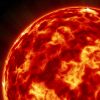NASA’s Parker Probe: Adventures to the Sun
“I really think these are transformative missions,” says Howard Singer, chief scientist at the Space Weather Prediction Center, of the three sun-focused missions occurring over the next few years. The Parker Probe, the Daniel K. Inouye Solar Telescope (DKIST), and the Solar Orbiter will embark on separate missions to create a better understanding of the star at the center of our system.
Your mother probably always told you, “Don’t stare at the sun.” That was pretty good advice that Betsy Congdon of the John Hopkins University Applied Physics Laboratory just didn’t heed. With her guidance, two dozen flybys of the sun will be completed by NASA’s $1.5 billion Parker Probe between now and 2024.
NASA’s Parker Probe
On August 12th, the Parker Probe lifted off from the Kennedy Space Center in Florida en route for Venus. 6 weeks from then, Venus’s gravity will shift the probe’s trajectory and point it towards the sun. Parker will then enter into the sun’s corona with Betsy Congdon’s carbon-foam heat shield protecting its delicate machinery from the sun’s 1370℃. This temperature doesn’t come from the million degree corona or the sun itself but rather the sheer glare of the sun. The probe will be sending back tons of information on the corona’s plasma and its magnetic fields.
The Parker Probe will travel closer to the sun than any probe ever has before. Parker will come within .04 AUs of the sun. One AU is equal to the average distance from the sun to the Earth. That is 7 times closer than the current record holders, the Helios probes deployed in the mid-1970s.
What information are the researchers hoping to glean from these trips around the sun? A few questions they have are regarding the sun’s corona and the solar winds that go whipping through space. The sun’s corona is 200x hotter than the sun’s surface but why? Additionally, solar winds, first described by the Parker Probe’s namesake Eugene Parker in 1958, have been puzzling scientists since they were discovered. These flybys of the sun may help explain how these streams of plasma particles are escaping into space and crashing into Earth’s magnetic field.
Shedding Some Light on the Sun
Scientists are still unsure about where the sun’s magnetic field is generated from. Understanding how and where it’s created could give scientists a better understanding of the rest of our solar system since the sun’s magnetic field is responsible for much of the space weather on earth such as our auroras. The solar magnetic system is also known to control the 11 year long cycle of the sun. It vacillates back and forth from solar minimum or the time of least solar explosions and solar maximum when solar explosions are more prevalent.
Representatives from all three of the solar-bound missions met earlier this year to determine how they could put their minds together to collaborate on unraveling the mysteries of the sun’s corona. “There is combined science that we can do that is going to be awesome,” said Valentin Martinez Pillet, director of the National Solar Observatory in Boulder, the organization in charge of creating DKIST.
We’re excited to learn more about our sun and hope that these projects provide clues to some long unanswered questions about what the sun's magnetic field influences. Stay up to date with us on our blog as developments arise on the Parker Probe and other NASA explorations.

